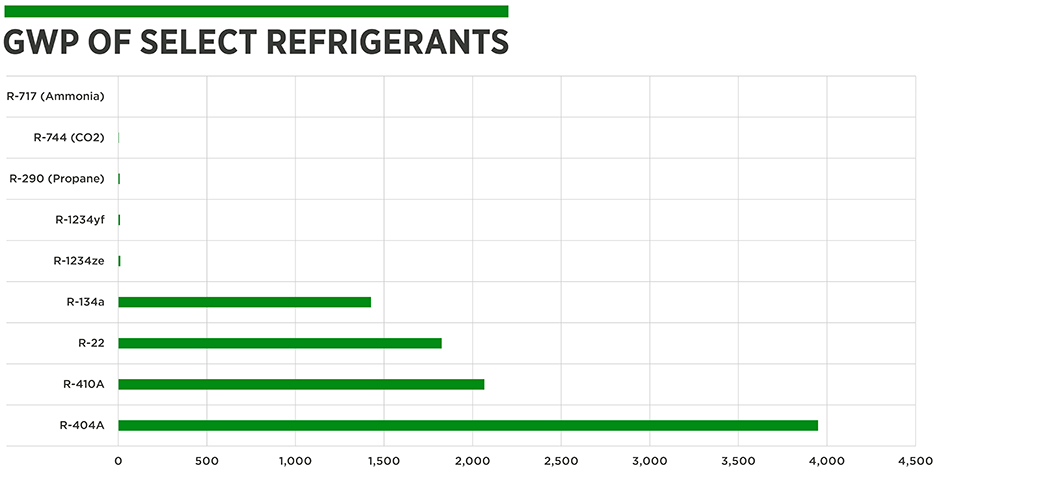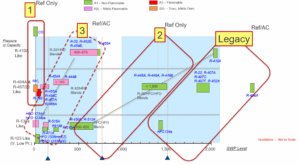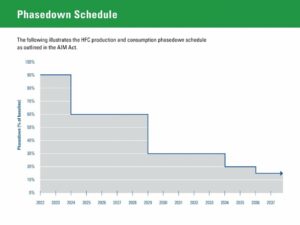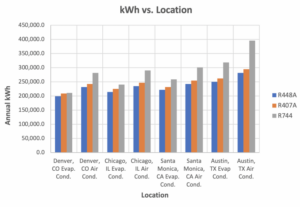In recent years, the grocery industry has seen an unprecedented demand for online shopping. To meet the needs of consumers making the switch to online shopping, many retailers are choosing to expand their warehouses and for grocers that means expanding their refrigerated warehousing. As the footprint of refrigerated warehouse space and infrastructure grows it’s important to understand how refrigerants align with corporate sustainability goals as well as how to plan for the evolving regulatory landscape.
With new and more stringent refrigerant regulations on the horizon, more clients are exploring alternative refrigeration systems as a means to holistically reduce annual greenhouse gas emissions. CO2, a natural refrigerant with an ultra-low environmental impact, has been an intriguing alternative refrigerant for quite some time, but higher costs associated with the equipment, installation, and operation have prevented CO2 from being widely adopted in the U.S. up until now. Fortunately, those previous barriers to CO2 systems are being overcome as greater familiarity and economies of scale are bringing initial costs down while regulatory restrictions continue to increase on traditional refrigerants.
When looking specifically at grocery stores, 40% of energy consumption is tied to refrigeration systems. The average store can contain up to two miles of refrigerant piping which is equal to the length of 30 football fields. These pipes and the systems can leak at a rate of 25% each year.
Switching to low-impact, sustainable refrigerants like CO2 will help reduce emissions by 108 gigatons globally. 108 gigatons is equivalent to the emissions from operating every home in the U.S. for 104 years or switching 4 trillion incandescent lamps to LED, or the amount of carbon sequestered by planting 1.7 trillion trees left alone to grow for 10+ years.
Regulations and GWP
Most refrigerants currently used in commercial refrigeration systems are synthetic refrigerants made of either hydrofluorocarbons (HFCs) or blends with both HFCs and Hydrofluro-Olefins (HFOs). These synthetic refrigerants have come under increasing scrutiny because of their high Global Warming Potential (GWP). GWP is defined by the U.S. Environmental Protection Agency (EPA) as “a measure of how much energy the emissions of 1 ton of a gas will absorb over a given period of time, relative to the emissions of 1 ton of carbon dioxide (CO2)”. Basically, a higher GWP translates to a higher contribution to global warming and climate change. Most HFC and HFO blends suitable for refrigeration currently used have GWPs ranging from the low 1,000s to nearly 4,000. CO2 has a GWP of 1.
For example, R407A, a widely used HFC, has a GWP of about 2,100, which means when released into the atmosphere, one pound would be 2,100 times more detrimental than one pound of CO2. Annual leak rates (the amount of refrigerant that leaks out of systems) can be up to 25% of the total refrigerant in the systems for a standard grocery chain. A 25% leakage rate for a grocery store refrigeration system with 1,200 pounds of refrigerant would therefore leak 300 pounds/year. In terms of GWP impact this R407A system would release the equivalent of 630,000 lbs. of CO2 into the atmosphere (300 lbs. x 2,100 GWP). The impact of a comparable CO2 based system would only be 300 pounds (300 x 1 = 300 lbs.) When we account for all the grocery stores and refrigeration systems around the world it starts to make sense how we could reduce overall CO2 emissions by 108 gigatons.
Federal and State Regulations
To reduce the GWP impact of refrigerant leaks, the EPA issued regulations restricting the use of certain HFC refrigerants in 2015. The EPA regulations have been argued back and forth in the courts but a federal court decision in April of 2020 upheld the regulation prohibiting switching from ozone-depleting substances to HFCs that have a high GWP. This ruling was an important step in limiting the planet-warming impact of HFCs and speeding up the adoption of existing, safer alternatives.
![]()
![]()
![]()

States have also passed legislation limiting the use of high GWP refrigerants. For example, in California, laws were enacted to prohibit the use of high GWP refrigerants R404a and R507a in new supermarket refrigeration systems starting in 2019. Furthermore, they require new, non-residential refrigeration equipment containing more than 50 lbs. of refrigerant to use refrigerants with a GWP of 150 or less. For other states, this type of legislation is still in the proposal and feedback phase, but California’s laws serve to indicate the type of restrictions that we can anticipate for high and even moderate GWP refrigerants in the coming years. The proposed GWP limit of 150 in California is particularly noteworthy because there are currently no commercially available options for non-toxic, non-flammable refrigerants with GWPs below 150. The chart below shows the different refrigerant options in use or development in relation to their relative pressure and GWP.

Chart courtesy of Emerson Climate Technologies
Legacy = HFC (high GWP) refrigerants
1 = Natural (low GWP) refrigerants. Note CO2 is the only non-toxic, non-flammable option
2 = More recent HFO blend (intermediate GWP) refrigerants
3 = Newer (lower GWP) refrigerants, not yet in commercial use
Clean Air Act: Section 608
In addition to the aforementioned regulations on high GWP refrigerants, the EPA’s Clean Air Act (CAA) Section 608: Regulatory Requirements for Stationary Refrigeration and Air Conditioning limits the allowable refrigerant leak rate on systems with more than 50 lbs. of refrigerant to 20% annually on commercial refrigeration and 30% annually for industrial process refrigeration. The CAA also specifies leak repair requirements and establishes guidelines for refrigerant reclamation, sales restrictions, technician certification, service practices, appliance disposal, equipment recycling, and recordkeeping. This rule was modified on February 26, 2020 so that some of these requirements, such as the leak repair requirements and associated recordkeeping and reporting provisions will only apply to ozone depleting refrigerants as of April 10, 2020. Nevertheless, these requirements are a bellwether for what can be expected at a state level in the coming years. The California Air Resources Board (CARB) already has a refrigerant management program which requires facilities with refrigeration systems containing more than 50 lbs. of a high GWP refrigerant to conduct and report periodic leak inspections, promptly repair leaks, and keep service records on site.
AIM Act
The Consolidated Appropriations Act of 2021 included the AIM Act. This act directs the EPA to phase down both the production and the consumption of HFCs in the United States by 85% over the course of the next 15 years. An HFC phasedown at the global level is expected to avoid up to 0.5° Celsius of global warming by 2100. At a national level, this is the most impactful legislation when it comes to HFC phasedown and regulation.

Chart courtesy of the EPA: https://hndrson.co/3xWEvr8
CO2 Systems
Transcritical CO2 systems use CO2 (R744) as the sole refrigerant and are so named because at 87.8°F CO2 reaches its critical point (the point at which a substance’s liquid and vapor phase boundaries converge and liquid and vapor become indistinguishable from each other) and above this temperature the high pressure side of the system operates supercritically or transcritically without condensing from a vapor to a liquid. Other CO2 refrigeration systems, such as CO2 cascade or CO2 liquid overfeed systems avoid the inefficiencies associated with operating transcritically but at the expense of using CO2 in conjunction with another (often high GWP) refrigerant and of incurring the associated costs and inefficiencies of adding additional heat exchangers and associated equipment. For the purposes of this discussion we will focus on transcritical CO2 systems.
CO2 Advantages
Because CO2 is the baseline when measuring GWP, its GWP is 1 and the use of CO2 refrigeration will allow retailers to future-proof their refrigeration systems against any upcoming refrigerant regulation changes at both the state and national level. Installation costs have been decreasing as installers have become more comfortable with CO2 systems. Some installers are even reporting lower installation costs compared to systems with synthetic refrigerants due to the smaller pipe sizes used on CO2 systems. Bill Zornes with Key Mechanical states that his company has seen installation costs that are approximately 10–12% less than traditional refrigerant systems with similar design styles. Key Mechanical has completed the installation of CO2 systems and Bill doesn’t foresee a big learning curve for those installers who are less familiar: “I believe there is a small learning curve on the service side, but once technicians understand the system has the same components and operates in the same manner as we have all known it to be, it’s quickly overcome. [On the] installation side, I see no real learning curves providing you are using best industry practices.”
Equipment costs are also coming down as more systems are installed throughout the United States. Hill Phoenix, a refrigeration system manufacturer based near Atlanta, GA, has installed more than 800 Transcritical CO2 systems in North America and more than 12,000 systems in the world under the brand Advansor. In 2020 Derek Gosselin, with Hill Phoenix, stated that the equipment costs vary based on design choices and location and that there still is a cost premium of 15–25% for CO2 systems vs. systems using synthetic refrigerants but that the costs are coming down. He notes that it is best to compare total installed cost, including equipment, refrigerant management, and installation. According to Derek, the total installed cost of a CO2 system can be as little as 5–10% higher compared to equivalently sized systems using synthetic refrigerants. In addition to the environmental considerations, the lower cost of the CO2 itself is another point in its favor. CO2 is generally about $4/lb. whereas most traditional refrigerants range from $34–100/lb.
Transcritical CO2 Challenges
The efficiency of every refrigeration system decreases as the saturated condensing temperature increases, but the deterioration in efficiency is more dramatic for transcritical CO2 systems. Transcritical CO2 systems can achieve equal or better efficiency than synthetic refrigerant systems at condensing temperatures at or below about 60–65°F, but as the ambient and condensing temperatures rise, the synthetic refrigeration systems become increasingly more efficient compared to transcritical CO2 systems. Thus, any comparison of the annual energy usage between the two systems will be heavily dependent on the location and climate chosen as the basis of the comparison. Chart 2 below gives the results of a study Henderson Engineers performed in 2016 to compare the annual energy usage between a transcritical CO2 system (R744) and systems using synthetic refrigerants R407A and R448A.

The conclusion of this analysis was that energy usage differences were minor in cooler climates but significant in warmer locations. When comparing the overall climate impact of a refrigeration system, the increased energy usage needs to be considered based on the carbon intensity of the electricity sourced from the regional grid. Even in the most unfavorable weather conditions (e.g. warm and wet areas such as Austin, TX), CO2 systems could have a lower life-cycle carbon footprint when factoring in the additional energy use, especially over time as renewable energy sources continue to come online.
Mitigating CO2 Challenges
Limits to compressor operating windows preclude operating CO2 compressors below a condensing temperature of about 55°F but advances in technology that allow lowering the minimum condensing temperature would make the advantages of a CO2 system more pronounced in lower ambient temperatures. Other technologies, such as the use of a separate flash gas compressor, would increase the efficiency of the CO2 system and should be considered. Other energy-saving technologies, such as parallel compression, ejectors and various low-superheat options are more commonplace for transcritical CO2 systems. Overall, there is reason to think that proper equipment selection and continuing technological advances will make CO2 competitive with synthetic refrigerant systems in cool to moderate climates. And in warmer and more humid climates where transcritical CO2 systems should be expected to use more energy than an equivalent synthetic refrigeration system, other factors such as government regulations and the desire to use natural refrigerants may dictate the use of CO2 refrigeration systems despite any energy penalties associated with the system.
Conclusion
The changing regulatory landscape is requiring our industry to look at alternatives to the traditional synthetic refrigeration systems. Sustainable refrigerant design will be a crucial component in grocery stores as they try to reduce their carbon footprint. Transcritical CO2 is not without its challenges, particularly in warmer climates such as those in the southern half of the continental U.S., but increasing contractor familiarity, decreasing manufacturing costs, and continuing technological advances are making CO2 refrigeration systems more viable than ever before.
To learn more about Henderson’s refrigeration and grocery expertise, click here.
Join our email list to get the latest design innovations, technical content, new projects, and research from Henderson’s experts delivered straight to your inbox.